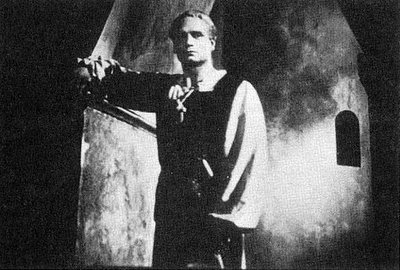
"Behind the arras"; I never get tired of that joke, telling it for the umpteenth time today in the Introduction to Drama course I teach at our local correctional facility. If a classroom of students is a captive audience, my work at the prison is blackboard heaven.
Determined to remind them that plays are primarily performance experiences, we watched Hamlet on video: Lawrence Olivier's version--by default; we may have high drama of all kinds at the prison, but none of it is on DVD, and the other movie versions weren't readily available to us on VHS, including Kenneth Branagh's 1996 behemoth, or Michael Almereyda's almost-SF version with Ethan Hawke, not to mention Franco Zeffirelli's take with Mel Gibson--"Lethal Hamlet," more or less. Olivier. I shrugged, even sighed. I was "teaching" Hamlet, fer petessake, not "enjoying" it; what were we supposed to do with Olivier's Freudian pretzel-knot? Aside from the usual eye-rolling because it's B&W, my students also had to deal with Olivier's rapid-fire delivery, not to mention the textual leaps and bounds and global elisions, in effect telling the Bard where he so often got it wrong. I asked my students to follow the film with their texts in front of them; the riffling reached hurricano proportions.
So as pedagogy it's in many ways a bust--but of course as a lesson in career-making acting, as well as a visual experience, it remains a constant pleasure. The visual style was particularly interesting for those of my students who had taken Introduction to Film Art (nice title) with me. We forgot for a while that we were in a drama class, and discussed how this was a noir Hamlet, with its rich chiaruscuro--many of them remember nothing at all from their time with me but that one word--and mood of inevitable doom. And we talked about how the story itself is a noir, albeit Val Lewton style, what with the ghost and weird locale). Hamlet, like so many noir heroes, is linked intimately to a crime, and becomes the sleuth, devising plots and traps, but still destined to see it all tighten like a noose until he's In a Lonely Place and there's No Way Out, the Force of Evil sneaking up on him Out of the Past; and, caught in the Crossfire, everyone faces the Big Sleep.
Of course, I'm drawing the noir cart before the Shakespearean horse; given the sickly descent, slow but vertiginous, of Hamlet--not to mention the madness and compulsions and degenerate scheming of Macbeth, King Lear, and Titus Andronicus, to name a few--it seems Olivier directed Hamlet at exactly the right time--1948--to give credit where credit is due: as usual, at Shakespeare's feet. He knew, as thoroughly as Sophocles, the queasy thrill of discovery, chase, and best intentions, all leading to revelation and those dreams that come at the untidy end of all effort. Olivier clamps his mitts on this with a vengeance--ha, ha--and delivers a moody, smoky, dim wonder, as much about the growing uncertainty of the post-World-War-II generation as Shakespeare's fear of the State literally losing its head, as it was wont to do. The result is typically modern, as Shakespeare can so easily be, if only because he reminds us that everything gets to be modern sooner or later, including the moody college kid from Denmark with too much time on his hands and a grudge to nurse and eventually fester.
No comments:
Post a Comment